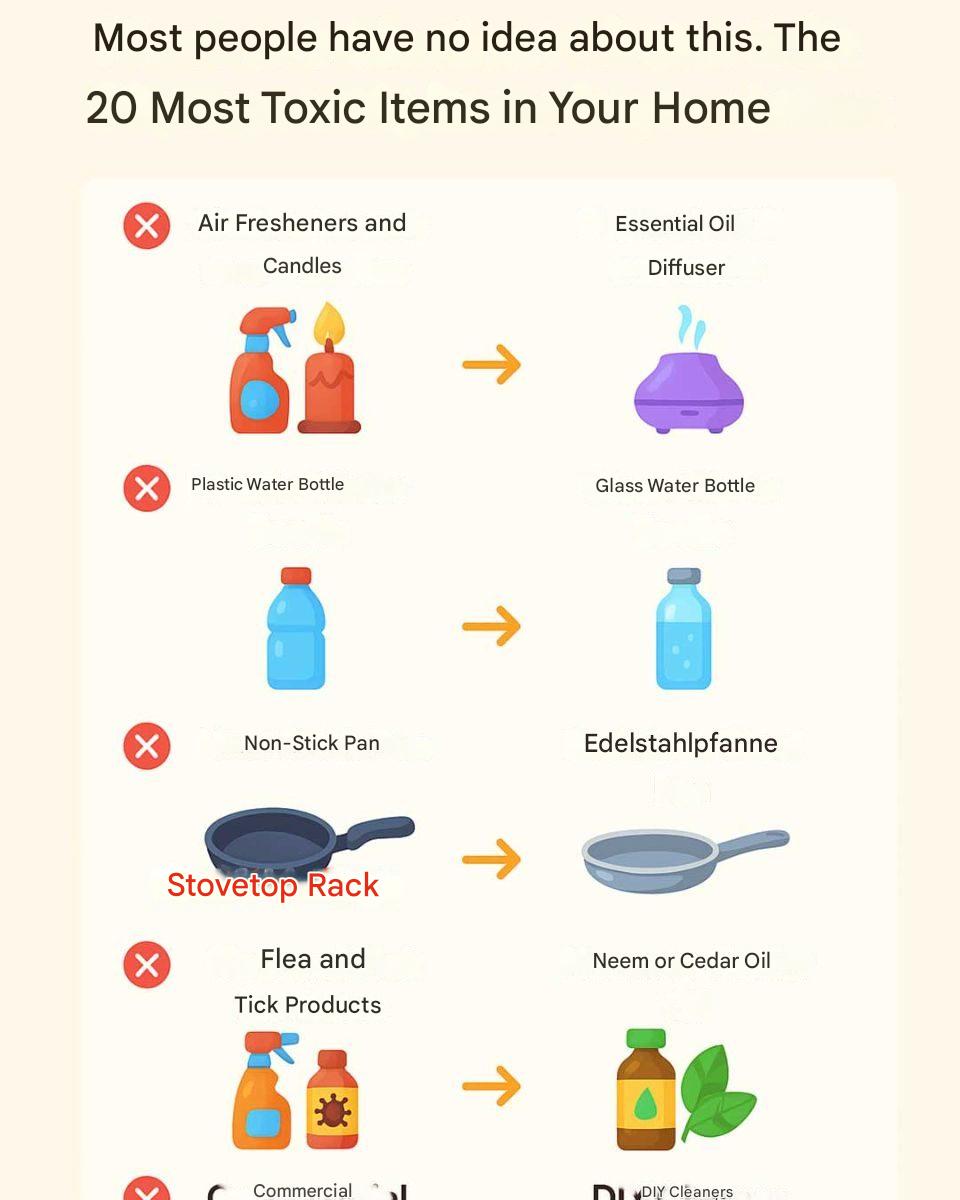
Most people have no idea about it. The 20 most toxic items in your home
13. Toilet Cleaners: The Hygiene Trap
Toilet cleaners often contain hydrochloric acid and bleach, which can be harmful if inhaled or come into contact with skin. Mixing these cleaners with other products can produce toxic gases.
Instead, use: scrub with baking soda and vinegar or use a natural toilet cleaner made from citric acid and essential oils.
Toilet cleaners often contain hydrochloric acid and bleach, which can be harmful if inhaled or come into contact with skin. Mixing these cleaners with other products can produce toxic gases.
Instead, use: scrub with baking soda and vinegar or use a natural toilet cleaner made from citric acid and essential oils.
14. Furniture Polish: The Shiny Deception
. Furniture polish can contain petroleum distillates and other chemicals that are harmful if inhaled. These products can contribute to indoor air pollution and pose health risks with prolonged exposure.
Alternatively, mix olive oil and lemon juice for a homemade polish, or use plant-based alternatives like Method or Ecover.
. Furniture polish can contain petroleum distillates and other chemicals that are harmful if inhaled. These products can contribute to indoor air pollution and pose health risks with prolonged exposure.
Alternatively, mix olive oil and lemon juice for a homemade polish, or use plant-based alternatives like Method or Ecover.
15. Paints and Solvents: The Artistic Anomaly
Paints and solvents often contain volatile organic compounds (VOCs), which can cause headaches, dizziness, and other health problems. Long-term exposure can lead to more serious conditions, including liver and kidney damage.
Use instead: Choose low- or no-VOC paints like those from Benjamin Moore Natura or ECOS Paints, and ensure good ventilation during application.
Paints and solvents often contain volatile organic compounds (VOCs), which can cause headaches, dizziness, and other health problems. Long-term exposure can lead to more serious conditions, including liver and kidney damage.
Use instead: Choose low- or no-VOC paints like those from Benjamin Moore Natura or ECOS Paints, and ensure good ventilation during application.
16. Pesticides: The Garden Gamble.
Pesticides in gardens and homes can contain chemicals that are harmful to both humans and the environment. Ingredients such as organophosphates and carbamates can cause neurological and respiratory problems.
Use instead: Try neem oil, diatomaceous earth, companion planting, or other integrated pest management methods.
Pesticides in gardens and homes can contain chemicals that are harmful to both humans and the environment. Ingredients such as organophosphates and carbamates can cause neurological and respiratory problems.
Use instead: Try neem oil, diatomaceous earth, companion planting, or other integrated pest management methods.
17. Chemicals in dry cleaning: Gambling with clothes.
Dry cleaning often uses perchloroethylene, a chemical that can cause dizziness, headaches, and breathing problems. Long-term exposure has been linked to more serious health problems, including cancer.
Use instead: Look for “wet cleaning” services or eco-friendly dry cleaners that use CO₂ cleaning or silicone-based alternatives like GreenEarth.
Dry cleaning often uses perchloroethylene, a chemical that can cause dizziness, headaches, and breathing problems. Long-term exposure has been linked to more serious health problems, including cancer.
Use instead: Look for “wet cleaning” services or eco-friendly dry cleaners that use CO₂ cleaning or silicone-based alternatives like GreenEarth.
18. Nail polish remover: The blemish.
Nail polish removers often contain acetone, a solvent that can cause skin and eye irritation. Inhaling acetone fumes can lead to headaches, dizziness, and breathing problems.
Use instead: Choose acetone-free removers made with natural ingredients like soy, or use plant-based removers with essential oils.
Nail polish removers often contain acetone, a solvent that can cause skin and eye irritation. Inhaling acetone fumes can lead to headaches, dizziness, and breathing problems.
Use instead: Choose acetone-free removers made with natural ingredients like soy, or use plant-based removers with essential oils.
19. Hair dye: The colorful concern.
Hair dyes can contain various chemicals, including ammonia and paraphenylenediamine, which can trigger allergic reactions and respiratory problems. Some studies suggest a link between hair dye use and cancer.
Instead, use henna, indigo, or semi-permanent herbal hair dyes like Naturtint or Herbatint, which do not contain harsh chemicals.
Hair dyes can contain various chemicals, including ammonia and paraphenylenediamine, which can trigger allergic reactions and respiratory problems. Some studies suggest a link between hair dye use and cancer.
Instead, use henna, indigo, or semi-permanent herbal hair dyes like Naturtint or Herbatint, which do not contain harsh chemicals.
20. Perfumes and Eau de Cologne: The Fragrance Misconception
Perfumes and eau de colognes often contain synthetic fragrances and phthalates, which can trigger allergic reactions and respiratory problems. These products can also contribute to indoor air pollution.
Instead, choose perfumes made from natural essential oils or create your own blend of jojoba oil and organic essential oils.
Perfumes and eau de colognes often contain synthetic fragrances and phthalates, which can trigger allergic reactions and respiratory problems. These products can also contribute to indoor air pollution.
Instead, choose perfumes made from natural essential oils or create your own blend of jojoba oil and organic essential oils.
Conclusion: Creating a safer living environment
Awareness is the first step toward a safer living environment. By recognizing and reducing exposure to these toxic substances, you can protect your health and that of your loved ones. Use natural alternatives, improve ventilation, and educate yourself about the products you bring into your home.